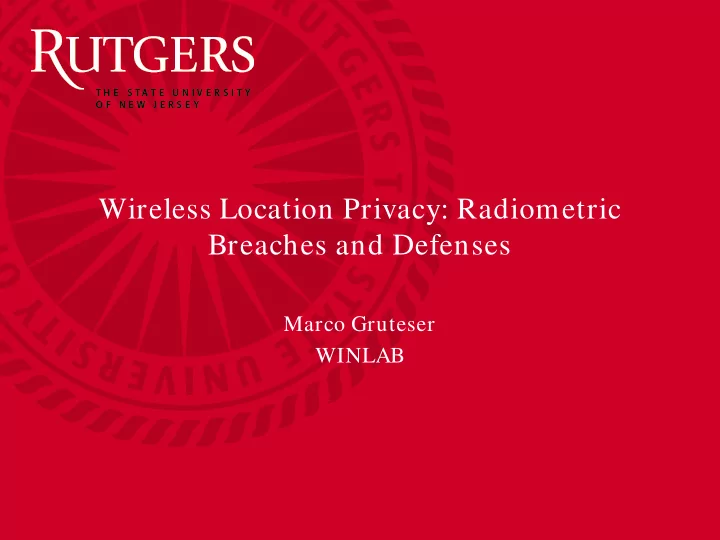

Wireless Location Privacy: Radiometric Breaches and Defenses Marco Gruteser WINLAB
Trends Always-on, transmitting Low-cost software (controlled) radios background apps (e.g., GNU radio)
Removing Identifiers at or above Bit-Level: Example Anonymization Access Control GPS Satellite Location Cellular Traffic Estimation Proxy Data mining and Service logging Provider Vehicle ID | timestamp | Lon | Lat | Speed | Heading ------------------------------------------------------------------ 254,18-oct-2006 10:11:12,-85.3452,42.4928,42.18,135 372,18-oct-2006 10:11:12,-85.3427,42.4898,63.72,100 182,18-oct-2006 10:11:12,-85.4092,42.4726,50.15,75 Probe 254,18-oct-2006 10:12:12,-85.3462,42.4998,45.18,135 Vehicles 372,18-oct-2006 10:12:12,-85.3512,42.4944,60.01,185 182,18-oct-2006 10:12:12,-85.4102,42.4753,45.88,235 … 254,18-oct-2006 10:21:12,-85.3856,42.5129,45.67,135 Anonymous Trace log files
Privacy Im plications at the Signal Level? Beyond Localization … • Possible Breaches – Identify transmitters? – Infer information other than location? • Protections – Prevent long-term tracking? – Thwart localization?
Recent Controversy about Human Mobility Article Demonstrates Location Privacy Sensitivities • Analyzed human mobility patterns from cell phone hand off data – 100,000 users over 6 months • Coarse data – Cell tower location recorded for each call / message – Average towers covered 3 km^ 2 • Example of typical assumptions about location inference from signals
Identifying Transmitters via Radiometric Signatures with Suman Banerjee (MobiCom’08)
Waveform Impairments in Analog Frontend
Transmitter Identification via Classification • Training phase: collect fingerprint (waveform error metrics) of each transmitter • Identification phase: measure error metrics for candidate transmitter and use classification algorithm to match with training set
ORBIT
Identification Results • Using ORBIT testbed radios and vector signal analyzer for data collection • K-Nearest Neighbor and Support Vector Machine classifiers
Identifying Co-location (While Moving) without Location With Rich Martin, Yingying Chen (MASS 08)
Motivating Applications • Co-location can reveal social relationships among device owners
Properties of Co-Mobile Transmitters Small scale fading � Fast fading differs but slow fading similar
Non- Co-Mobile Transmitters Both large and small scale fading differs
Detection via Filtering and Time- Series Correlation � Pearson’s Product Moment Correlation Coefficient:- Determines the Linear Relationship between two Random Variables (Observed RSSI from 2 Devices) � Ranges between [-1, +1] – 0 : No Correlation – +1 : Strong Positive Correlation – -1 : Strong Negative Correlation
Experimental Setup
Impact of Speed on Co-Movement Detection Time Correlation-Coefficient Threshold >= 0.6 Conclusion: 50-100 Sec of Observation Required.
Thwarting Tracking: Applying Path Cloaking with Hui Xiong (CCS 07)
Inference/ Insider Attacks Compromise Location . Privacy . . . . . Still insider breaches and remote break-ins possible . . . . . . Re-identification . of traces . . through data . analysis Tracking algorithms recover individual trace [Hoh05] (Median trip time only 15min) Anonymous Home Trace log Identification files [Hoh06] Location may be precise enough to identify home
Stronger De-identification for Location Traces: Filtering based on Tracking Model t=T 2 t=T 1 d 1 t=T 2 d 2 t=T 1 d 1 t=T 2 d 3 d 2 t=T 2 d 3 t=T 2 Low Entropy High Entropy t=T 2 Low Uncertainty High Uncertainty Uncertainty Normalization
Thwarting Precise Localization Preliminary Work
(X1,Y1) 3db Power Control?
3db Power Control Provides Little Benefit (X1,Y1) 3db 3db 3db
Cooperation can yield Asymmetric 3db Signal Changes 1db 0db
Proof-of-Concept Result 18 18 Victim Node 17 12dBm 17 16 Cooperator−1 16 15 Decoy Location −1 15 14 14 13 13 12 12 6dBm Grid − y Grid − y 11 11 10 10 6dBm 9 9 8 8 7 7 1dBm 6 6 Victim Node 5 1dBm 5 Cooperator−2 4 4 3 12dBm 3 Decoy Location−2 2 2 4 5 6 7 8 9 10 11 12 13 14 15 16 4 5 6 7 8 9 10 11 12 13 14 15 16 Grid − x Grid − x
t=T 2 t=T 2 t=T 2 d 1 d 2 d 3 t=T 1 3db Summary 1db 0db
Thank you
Recommend
More recommend